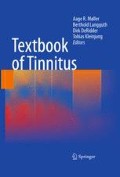Keypoints
-
1.
Noise-induced hearing loss (NIHL) is often associated with tinnitus.
-
2.
The shape and depth of the audiogram in patients with NIHL varies considerably.
-
3.
Characteristics of tinnitus (sensation level, pulsatile versus continuous, perceived pitch) also vary widely across individuals.
-
4.
The relationship between the pattern of hearing loss and the characteristics of the tinnitus is complex and a relevant topic of research.
-
5.
This chapter focuses on three topics relevant to NIHL and tinnitus:
-
(a)
The relationship between the parameters of a noise exposure and the resulting hearing loss.
-
(b)
The cochlear pathologies underlying permanent hearing loss and temporary hearing loss and how they differ.
-
(c)
Noise-induced tinnitus and the animal modeling of tinnitus used to study the relationship between noise and tinnitus.
-
(a)
Access this chapter
Tax calculation will be finalised at checkout
Purchases are for personal use only
Abbreviations
- ATS:
-
Asymptotic threshold shift
- CNS:
-
Central nervous system
- EAM:
-
External auditory meatus
- GPIAS:
-
Gap-prepulse inhibition of the acoustic startle
- IHC:
-
Inner hair cell
- NBN:
-
Narrow band noise
- NIHL:
-
Noise-induced hearing loss
- NIOSH:
-
National Institute for Occupational Safety and Health
- OHC:
-
Outer hair cell
- OSHA:
-
Occupational Safety and Health Administration
- PTS:
-
Permanent threshold shift
- TTS:
-
Temporary threshold shift
References
Henderson D, M Subramaniam, MA Gratton et al (1991) Impact noise: the importance of level, duration, and repetition rate. J Acoust Soc Am 89:1350–7.
Henderson D and RP Hamernik (1995) Biologic bases of noise-induced hearing loss. Occup Med 10:513–34.
Liberman MC (1990) Quantitative assessment of inner ear pathology following ototoxic drugs or acoustic trauma. Toxicol Pathol 18:138–48.
Saunders JC, SP Dear and ME Schneider (1985) The anatomical consequences of acoustic injury: A review and tutorial. J Acoust Soc Am 78:833–60.
McFadden D and FL Wightman (1983) Audition: some relations between normal and pathological hearing. Annu Rev Psychol 34:95–128.
Davis H, CT Morgan, JE Hawkins et al (1943) Temporary deafness following exposure to loud tones and noise. Acta Otolaryngol Suppl LXXXVIII.
Jerger JF (1952) A difference limen recruitment test and its diagnostic significance. Laryngoscope 62:1316–32.
Ward WD (1968) Susceptibility to auditory fatigue. Contrib Sens Physiol 3:191–226.
Carder HM and JD Miller (1971) Temporary threshold shifts produced by noise-exposure of long duration. Trans Am Acad Ophthalmol Otolaryngol 75:1346–54.
Carder HM and JD Miller (1972) Temporary threshold shifts from prolonged exposure to noise. J Speech Hear Res 15:603–23.
Mills JH (1973) Temporary and permanent threshold shifts produced by nine-day exposures to noise. J Speech Hear Res 16:426–38.
Bohne BA (1977) Growth of cochlear damage with increasing severity of exposure. Trans Sect Otolaryngol Am Acad Ophthalmol Otolaryngol 84:420–1.
Nordmann AS, BA Bohne and GW Harding (2000) Histopathological differences between temporary and permanent threshold shift. Hear Res 139:13–30.
Puel JL, C d’Aldin, J Ruel et al (1997) Synaptic repair mechanisms responsible for functional recovery in various cochlear pathologies. Acta Otolaryngol 117:214–8.
Pujol R and JL Puel (1999) Excitotoxicity, synaptic repair, and functional recovery in the mammalian cochlea: a review of recent findings. Ann N Y Acad Sci 884:249–54.
Zheng XY, J Wang, RJ Salvi et al (1996) Effects of kainic acid on the cochlear potentials and distortion product otoacoustic emissions in chinchilla. Hear Res 95:161–7.
ISO1999 (1990) Acoustics – determination of occupational noise exposure and estimation of noise-induced hearing impairment. International Organization for Standardization.
Mills JH, WY Adkins and RM Gilbert (1981) Temporary threshold shifts produced by wideband noise. J Acoust Soc Am 70:390–6.
Henderson D and R Hamernik (1986) A parametric evaluation of the equal energy hypothesis, in Basic & Applied Aspects of Noise Induced Hearing Loss, R Salvi et al, Editors, pp 369–78.
Bohne BA (1976) Safe level for noise exposure? Ann Otol Rhinol Laryngol 85:711–24.
Ward WD, PA Santi, AJ Duvall, 3 rd et al (1981) Total energy and critical intensity concepts in noise damage. Ann Otol Rhinol Laryngol 90:584–90.
Henderson D and RP Hamernik (1986a) Impulse noise: critical review. J Acoust Soc Am 80:569–84.
Hamernik RP, G Turrentine, M Roberto et al (1984) Anatomical correlates of impulse noise-induced mechanical damage in the cochlea. Hear Res 13:229–47.
Morest DK, J Kim, SJ Potashner et al (1998) Long-term degeneration in the cochlear nerve and cochlear nucleus of the adult chinchilla following acoustic overstimulation. Microsc Res Tech 41:205–16.
Salvi RJ, J Wang and D Ding (2000) Auditory plasticity and hyperactivity following cochlear damage. Hear Res 147:261–74.
Kaltenbach JA and CE Afman (2000) Hyperactivity in the dorsal cochlear nucleus after intense sound exposure and its resemblance to tone-evoked activity: a physiological model for tinnitus. Hear Res 140:165–72.
Sun W, L Zhang, J Lu et al (2008) Noise exposure-induced enhancement of auditory cortex response and changes in gene expression. Neuroscience 156:374–80.
Author information
Authors and Affiliations
Corresponding author
Editor information
Editors and Affiliations
Rights and permissions
Copyright information
© 2011 Springer Science+Business Media, LLC
About this chapter
Cite this chapter
Henderson, D., Bielefeld, E.C., Lobarinas, E., Tanaka, C. (2011). Noise-Induced Hearing Loss: Implication for Tinnitus. In: Møller, A.R., Langguth, B., De Ridder, D., Kleinjung, T. (eds) Textbook of Tinnitus. Springer, New York, NY. https://doi.org/10.1007/978-1-60761-145-5_37
Download citation
DOI: https://doi.org/10.1007/978-1-60761-145-5_37
Publisher Name: Springer, New York, NY
Print ISBN: 978-1-60761-144-8
Online ISBN: 978-1-60761-145-5
eBook Packages: MedicineMedicine (R0)

